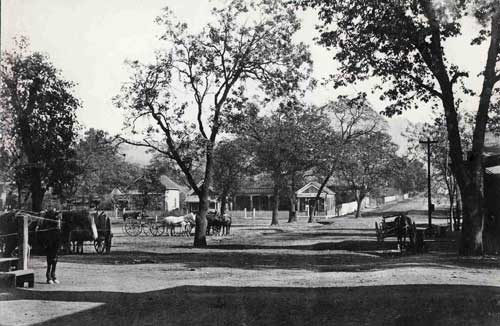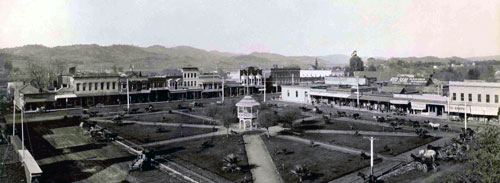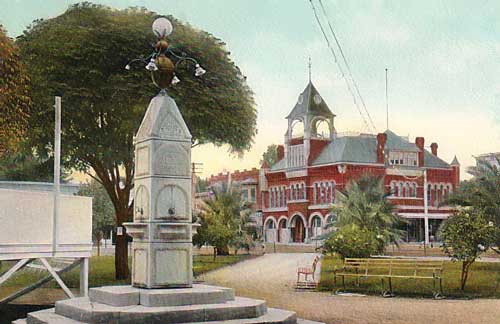|
|
urHealdsburg.com |
|
|||||||||||||||||
|
|
|||||||||||||||||||
|
The Healdsburg Plaza Kale`Picture an oak and madrone forest, sunlight casting dappled patterns on a ground of spiky, clumped grass. Nearby a small lake lies as calm as a green-tinted mirror. On the banks of this lake are a dozen or more rounded brush huts and the smoke from cooking fires spirals up along with the voices of playing children.
A visitor to the site that we now call the Healdsburg Plaza might well have seen just this two hundred years ago. The Pomo Indian village of "Kale" sat in the ancient groves that once covered a large part of the Russian River Valley. The lake, which once extended south from the present Matheson Street, may have given the village its name, which means "water-midst". Or the name could have referred to the village's location at the confluence of a creek named "Mihilakawna" (Dry Creek) and a river named "Ashokawna" (Russian River). Acorns from the many oaks, nuts from the black walnuts, seeds, berries, fish, and game were plentiful here, and life went on in traditional ways. The occasional visits of European sailing vessels on the California coast from the early 1500's to the early 1800's did not greatly change life here. But the founding of Fort Ross by Russian colonists in 1812 and the establishment of Mission Dolores in San Francisco in 1776, and later Mission San Rafael and Mission San Francisco de Solano in Sonoma by the Spanish and Mexicans, did have a great impact on the little village. The Russians were generally on good terms with the Pomo, sometimes taking Pomo women as wives, and carrying on considerable trade with many of the family groups. The encounters with the Mission fathers and the soldiers sent to protect them were often less friendly, as the soldiers sometimes kidnapped the local Indians to use as laborers in the mission fields. Armed retaliatory raids against the local tribelets also took their toll. The single greatest tragedy for the Indians came simply because of contact with Europeans and Americans, who carried powerful foreign diseases to these unprotected people. By the 1840's these combined forces had wiped out the peaceful village of "Kale`", which once covered most of the Plaza and the area immediately west.[1] Grizzlies and FuneralsYet the oak and madrone forests that had shaded Kale` were still there in 1841 when the area became part of the more than 48,800 acre Rancho Sotoyome, granted to Captain Henry Delano Fitch. Town legend holds that Cyrus Alexander, who managed the cattle ranch for Fitch, used one very large madrone tree on the Plaza site to hang the carcass of a bear he killed there in the early 1840's.[2] Harmon Heald picked a spot near the Plaza in 1851 when he built his first little "squatter's" cabin. He was looking for a sunny, but protected spot out of the dank gloom of the redwoods to recover from the illnesses he contracted on the journey across the plains. An early settler at "Heald's Store", as it was known in 1856, described the Plaza site as a "beautiful shady grove".[3] When Harmon Heald's wife, Sarah, died in 1857, the funeral was held outdoors on the Plaza, a church having not yet been built. One who attended that funeral described the Plaza as "covered with large oaks with but one or two madronnas".[4] Although it is difficult to identify all of the native species of trees that once shaded the Plaza and town site, photographs from 1864 to 1873 suggest that the it was covered with Pacific Madrone, Black Oak, Valley Oak, Coast Live Oak, and Black Walnut. The Indians may have transplanted the Walnut to their village sites.
|
|||||||||||||||||||
|
|
Citizens Invited to Plant
Now that it was cleared for improvement, the Council invited all interested citizens to plant trees and shrubs in the Plaza, which they did, seemingly at random. By 1876 they had filled the plaza with tiny fir trees, cypress, and had bordered it with Eucalyptus. In the very center they planted exotic palms.[13]
Although the firs were a native California touch, perhaps a remembrance of the journey over the Sierras, these plantings also exhibited the taste for the exotic that flourished in California during that era, especially the pervasive Eucalyptus imported from Australia.
Even these efforts fell short, for only two years later the newspaper began to agitate for further beautification, including the planting of Kentucky Blue Grass, irrigation, and iron benches for visitors.[14] The unkempt appearance of the Plaza had an unfavorable effect on visitors, the paper claimed. "Hard times" following the economic "Panic" of 1873 delayed further work until late 1880, when the first structure on the site was designed.
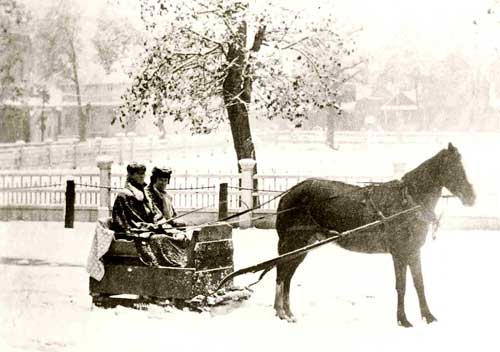 |
|
|
Bell Tower. A Painted Lady
In December 1880, the City of Healdsburg purchased a 778 pound bell from the Christian College in Santa Rosa. Immediately thereafter work began on a large enclosed bell tower in the center of the Plaza. The nearly completed "City Fire Tower" received the bell and tested its voice on January 6, 1881. She sounded loud and clear, serving for many years to call the volunteer fire brigade, gather townsfolk in emergencies, or ring out joyous news.[15]
With its many trees, lacy fence, and now a lofty civic spire and bell as centerpiece, the citizens of Healdsburg seemed satisfied with their Plaza. Encircled by a row of Eucalyptus, the lot now supported approximately 35 cypress and fir trees in various stages of growth.
Still, without regular maintenance the Plaza often looked unkempt. When the editor of the Healdsburg Enterprise newspaper called the Plaza an "eyesore", a movement to clean it up began that was repeated annually. Not all of the improvements made during this era were equally appreciated and it was about this time that disagreement arose about the appearance and use of the Plaza.
For example, in 1892 enthusiastic citizens gave the wooden bell tower a new coat of paint, apparently in very bright colors. Many other citizens felt the colors were in poor taste, and it was reported that the majority "would have preferred white".[16]
A Party Place
With its central location, the Plaza also became a party place. Local businessmen were the first to recognize the advantage of such gatherings in a picturesque setting, conveniently encircled by their shops.
Fourth of July celebrations on the Plaza began at least as early as 1866. A reported crowd of 2,000 gathered in that year to hear orations, to watch the parade, and later enjoy the evening pyrotechnics.[17]
In 1877 a May Day Festival was established. This first festival featured a "Knighthood Tournament", wherein mounted riders tried to spear brass rings with lances while galloping at high speeds. By 1879 the event was drawing close to 5,000 people, almost three times the population of the town. The main event was always the parade of the Floral Queen and her attendants around the Plaza. As each year built upon the last the event grew more elaborate. In 1895 the festival was a three day extravaganza with a mile long parade around the Plaza.
After 1896 the Floral Festival, as the May Day spectacular was now known, was combined with the Independence Day celebration and the "Floral Queen" was replaced with the "Goddess of Liberty".
Fourth of July celebrations tapered off about 1925, when a reported crowd of 15,000 gathered at the park. The economic effects of Prohibition on this grape and hop growing region, and later the onset of the Great Depression, caused the discontinuation of the large Plaza festivals.[18]
Miss Bell Tower, Scorned by Band
Almost as soon as a town band became well established in the 1880's the Healdsburg Plaza became its unofficial headquarters. The Plaza was a perfect location for regular seasonal Saturday night band concerts drawing people from far and wide. The Healdsburg concerts were economical. They cost next to nothing and admission was free. They brought trade for local business because shops stayed open until 9 p.m. on those nights. The concerts also provided much needed entertainment and social opportunities.
Requests for a permanent bandstand, to replace a temporary one constructed annually next to the bell tower, had been made for years. But in 1895 a concerted movement for civic improvement began in Healdsburg. This movement, which in other spheres resulted in a municipally-owned water and electric plant, had a drastic effect on the Plaza, and pushed the question of the band concerts to the forefront.
It all started with agitation by the local newspaper and citizens beginning in April 1895, resulting in the destruction of old "Miss Bell Tower" in 1896. Barely 15 years old, she was now considered an "eyesore" and was accused of causing false fire alarms with her rickety frame in high winds.[19]
A new circular bandstand appeared in her place, a gazebo-like structure with a conical roof built upon the old bell tower legs. Following the elaborate styles of that era, it included open banister work, fancy brackets and cornices, and a "swaying" staircase”.[20] This whimsical Victorian bandstand soon became a favorite gathering place, especially for young single men and women who would assemble on warm evenings after chores were done.[21]
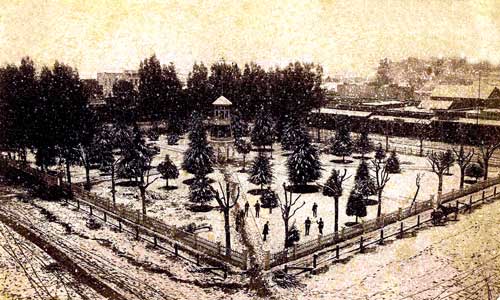 |
|
|
Lady Imps Ignite Firestorm
Perhaps it was the popularity of the bandstand as a magnet for socializing, and the ever-increasing fame of the Saturday night concerts, which led to its controversial downfall only three years later. Those concerts inevitably involved the consumption of liquor, either in nearby saloons or from pocket flasks.
One aspect of the progressive spirit that seized the town included the Temperance Movement to ban the use of alcohol. Following the lead of Temperance Leagues throughout California, a local group, the Ladies Improvement Club, received permission from the City Trustees to replace the bandstand with a central drinking fountain. Such civic water fountains had been installed in many towns as a symbol of the determination to outlaw stronger refreshments.
A drinking fountain could have been placed almost anywhere on the Plaza, but the "Lady Imps", as they were known to some, were set upon the destruction of the bandstand and its unsavory influence. They ignited a firestorm of controversy by proposing the removal of the town's favorite gathering place. The City Trustees, caught in the middle of this passionate debate, became mired in indecision.
When a citizen's petition began to circulate to save the bandstand, the Ladies Improvement Club, intent upon their Higher Purpose, had the bandstand hurriedly axed down. This rash action started a year-long battle between community factions, played out on the Plaza, in the newspapers, and at City Trustee meetings.
Hoodlums Scrawl Indecent Graffiti
On April 12, 1900 the Healdsburg Tribune reported that a group of young people had played a hoax on the "Lady Imps". In the dark of night they erected a fake "marble" monument in the center of the Plaza, built out of wood with muslin stretched over it. The newspaper fumed over the "indecent" graffiti that was scrawled upon the thing, stating, "The sentiments expressed on the monument were worthy of Barbary Coast hoodlums".
The Ladies Improvement Club, determined to have their symbolic drinking fountain, would not be swayed. The young people and most shop owners wanted a bandstand. Some businessmen wanted something else altogether, suggesting an elaborate "electric fountain", consisting of large sprays of water lit by multi-colored lights. This idea was modeled after an exhibit at the 1894 California Midwinter Exposition in San Francisco. Although expensive, such a spectacular display might draw out-of-towners, they reasoned. The Plaza had become the visible battleground for a war waged between competing community values and interests.
With the help of an attorney, the "Lady Imps" finally prevailed over all, and the drinking fountain was dedicated on May 1, 1901. Not completely defeated however, the rest of the community immediately erected a temporary bandstand next to the fountain, which was succeeded by a permanent one donated by local businessmen in 1915.[22] By that time the “Lady Imps” may have lost political power.
And the band played on.
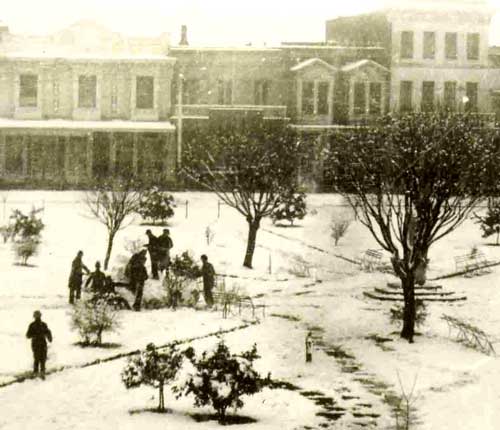 |
|
Building a snow mountain in the Plaza about 1905. Looking west to buildings on West Street (Now called Healdsburg Avenue). - image, Healdsburg Museum. |
Landscaping Fads
Landscaping fads visited the Plaza regularly in its early years. In the late 1880's the unruly Eucalyptus trees were felled along with the many fir trees. The surviving cypress trees were meticulously trimmed to resemble small, widely-spaced toadstools in an otherwise bare plot. This mystifying manifestation can be explained by the popularity of sculptured, open, Italianate formal gardens in that era. Replacing the heavy picket and post perimeter fence with wire mesh extended the feeling of open space.[23]
The Plaza evolved from the stiff formality of the Italianate period to a more relaxed, naturalistic style. Near the end of the last century businessmen and developers in southern California began to promote the state as a "tropical" paradise. Healdsburg officials were probably emulating that movement in 1897 when they planted the Plaza with exotic Canary Island Date Palms, Washington Palms, orange and lemon trees, and a profusion of rose bushes.[24]
As the native redwoods receded on surrounding hilltops and became a symbol of the vanishing western wilderness, they were added as an ornament to the park. Some were planted as early as 1900. One of the species is a rare deciduous variety from China known as the "Dawn Redwood".
With a few periodic additions, the Plaza remained essentially unchanged from 1901 until 1960. The marble drinking fountain, palms, and bandstand appear on postcard after postcard, decade after decade, distinguishable only by the increasing height of the trees and the changing backdrop of plaza buildings.
Rethinking the Plaza
In 1960 the winds of civic improvement and modernization once again swept through Healdsburg. At the same time that a new City Hall and fire station were underway, attention turned to the Plaza. A landscape planner, Burton Litton of Berkeley, was hired in that year to rethink the park. His plan, along with the older Canary Island Date Palms and redwoods, are what we now see in the center of town.
At the same time Elmer J. Sandborn donated $1,000 for a new public fountain. The granite drinking fountain/monument that had caused so much furor and consternation in 1900 succumbed without controversy sixty years later. A low-lying modernistic fountain replaced it. Recently boarded up, the bench type structure now forming the focal point of the town park often puzzles visitors.
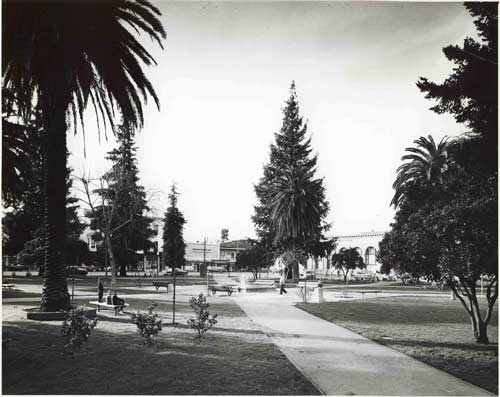 |
|
|
Nothing of note was added to the Plaza for the next quarter of a century until the "Plaza Pavilion" was dedicated in September 1986. So as not to disturb the 1960 central fountain, the Pavilion was built on the east end of the park. Designed by the late local architect, Michael Rubenstein, its Post-modernist style faintly echoes the short-lived 1897 gazebo bandstand.
Soap Box Stop
Although the winds of change abated on the Plaza after 1900, it continued to figure ever more prominently in the social and political life of the area. The Plaza served as a focus of state and regional politics. It was a strategic stopping place for soap box orators and campaigning politicians, drawing gubernatorial candidates or governors in 1898, 1902, 1910, 1917, and 1928. Large rallies or debates boomed from the park in almost every state and national election year until the 1930's, when radio cut into the popularity of the public speaking circuit[25]
The Plaza Saturday night band concerts, an entrenched local institution, drew large crowds until the 1950's. After surviving the onslaught of the Ladies Improvement Club, the band played on through wars and economic downturns. The concerts finally surrendered to that revolutionary new invention of the 1950's, the television. If local families could watch The Honeymooners or the Lawrence Welk Show, they no longer needed to meet their neighbors on Saturday night or sway to the rhythms of Owen Sweeten and his Orchestra.
Over its 136-year history the Plaza reflected a consensus of taste and morality in Healdsburg. It has also reflected the fiery debates needed to reach that consensus. We can thank town founder, Harmon Heald, for donating that hospitable plot of land whose slowly evolving costume has attracted so many generations of admirers.
© 2003 Hannah Clayborn
